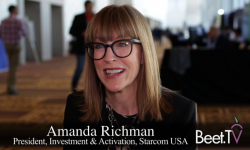LOS ANGELES — For TV advertisers eager to see the effect of their campaign more quickly, a US- and India-based company claims to have the answer.
Alphonso, which offers the ability for buyers to serve ads on to digital devices based on an understanding of consumers’ TV viewing behaviour, also this month launched closed-loop attribution.
The product is the paid version of the company’s otherwise-free Alphonso Insights, using data tracking from partners like SafeGraph, IRI and MasterCard.
“‘Did my TV campaign work?’,” Alphonso chief revenue officer Mark Gall asks in this video interview with Beet.TV. “TV to closed-loop attribution organisations doing analysis (take) six months …getting a report.
“We’re able to shrink the amount of time from weeks and months and quarters… to a couple of days
“You can take a TV creative, measure back and see the results. What was the foot traffic to the store, to the dealership? That’s never been done before. You used to have to wait a month and a half.”
Alphonso suite includes real-time data on what’s being aired across more than 200 US TV networks. It then uses automated content recognition (ACR) technology embedded on consumer devices like smartphones to listen out for what’s airing on nearby TVs.
The ensuing data, indicating what consumers are watching, can be used to target ads on digital devices. But a better way of looking at it may be to target based on what consumers are not watching, Gall says.
We have known for years how brands recognise consumers are “second-screening”, using a phone or tablet to distract themselves from TV commercial breaks.
“If people are looking down (at their phone) when my commercial comes on – that million-dollar, beautiful commercial – I’ve got to think, is that beautiful TV ad now a really expensive radio ad?,” he says. “We can take that, and serve that same ad … in your lap, to a phone, tablet or desktop.”
This video is part of series produced in Los Angeles at the 4A’s Transformation ’17. The series is sponsored by Extreme Reach. For more videos from the conference, please visit this page.



























